It all began with a pilgrimage. In the Jubilee year 1500, Battista Graziani, known as Garzadori, traveled to the Holy Land and, having arrived on the banks of the Jordan River, vowed to build a shrine, dedicating it to the saint who baptized Christ in those very waters, if he returned safely to his homeland. The return voyage evidently went well, and on November 26 of that same year Garzadori-a prominent figure in Vicenza’s economy at the time, an amateur poet and count palatine-asked the prior of the church of Santa Corona in Vicenza to grant him space to build a chapel that would also serve as the family’s sepulchral tabernacle. Work began in 1501, and various ancient sources describe the operations for the setting up of the apparatus, consisting of twisted columns or covered with leaves in relief, cornices, reliefs, figures in the round, inserts in porphyry, lapis lazuli or precious marbles coming precisely from the territories visited during the pilgrimage. The work is generally attributed to Tommaso da Lugano and Bernardino da Como, probably with the participation of Rocco da Vicenza.
At the center of that elaborate scenic machine-animated by a phantasmagorical water-bound population, as well as cherubim, festoons of flowers and fruit, and cornucopias-Garzadori wanted an altarpiece depicting the Baptism of Christ and commissioned the work from one of the most famous painters in the Veneto area, Giovanni Bellini. At that time the artist was devoting himself mainly to secular commissions, and in particular to redoing canvases for the Doge’s Palace in Venice, a commission that earned him the appointment as official painter of the Serenissima in 1483. His role as a painter of sacred subjects, which he held until the 1480s, had been taken over by Cima da Conegliano, but as we shall see the return to religious scenes was an important opportunity for the elder Bellini to renew his language, at the same time establishing new models from which younger artists were inspired.
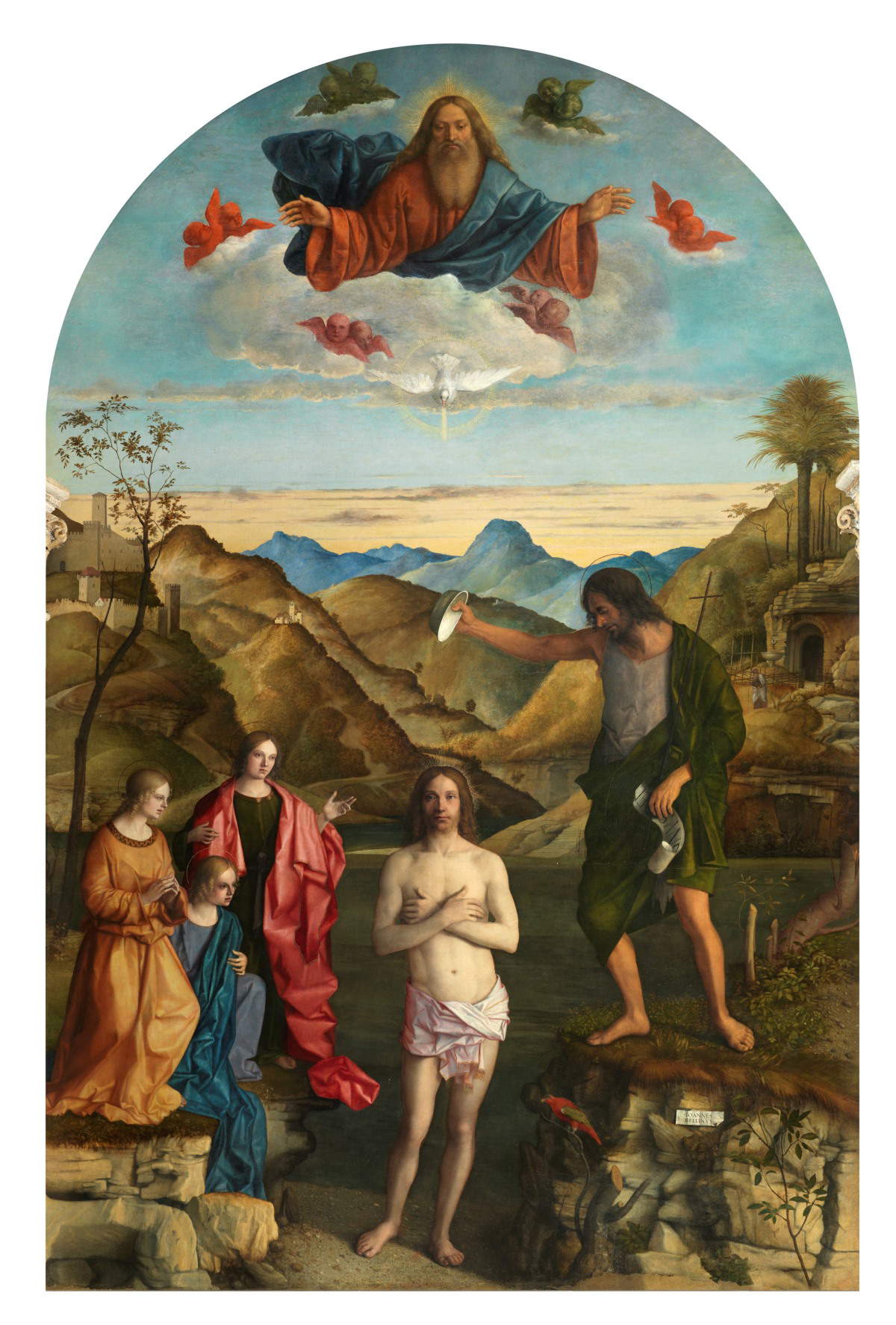
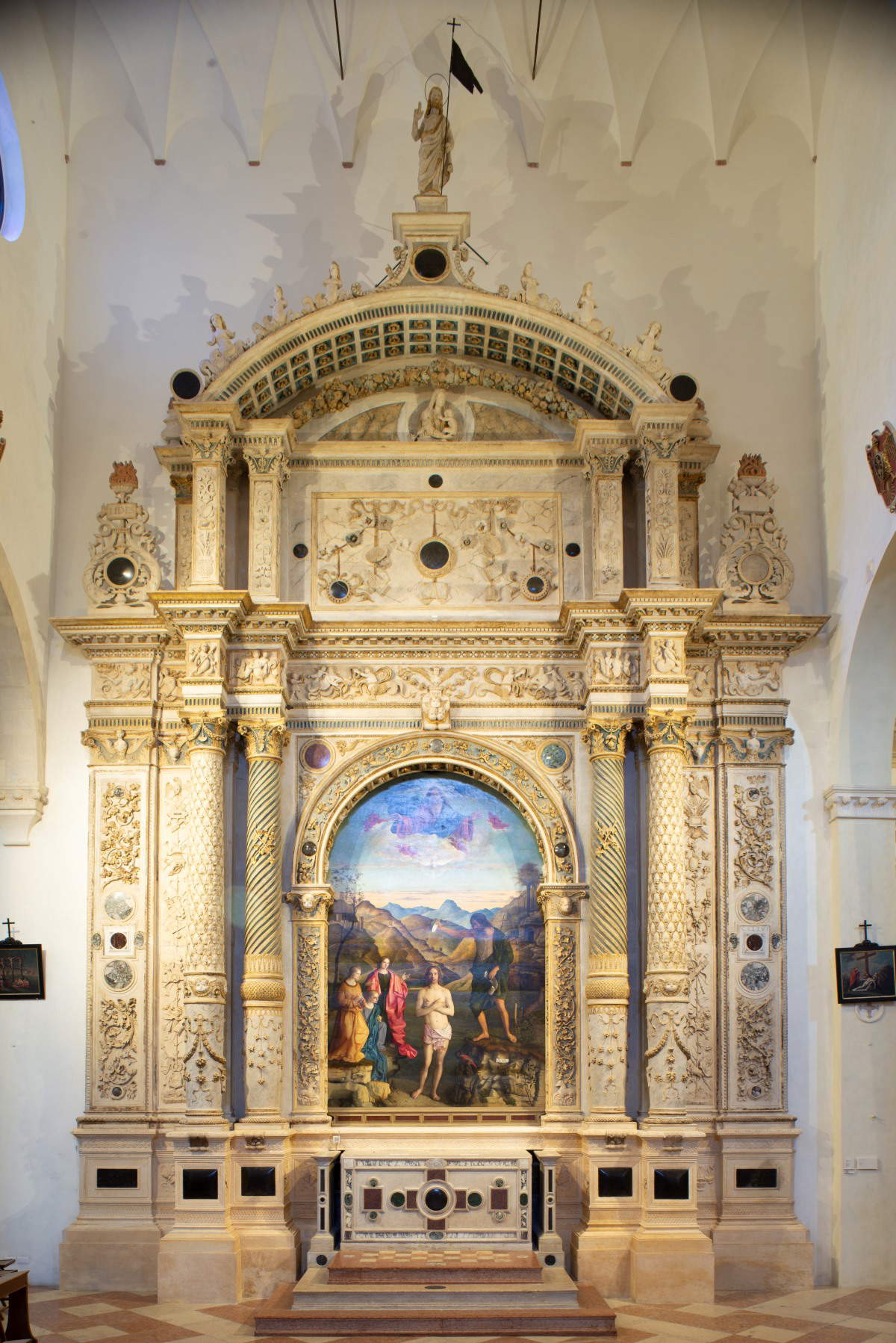
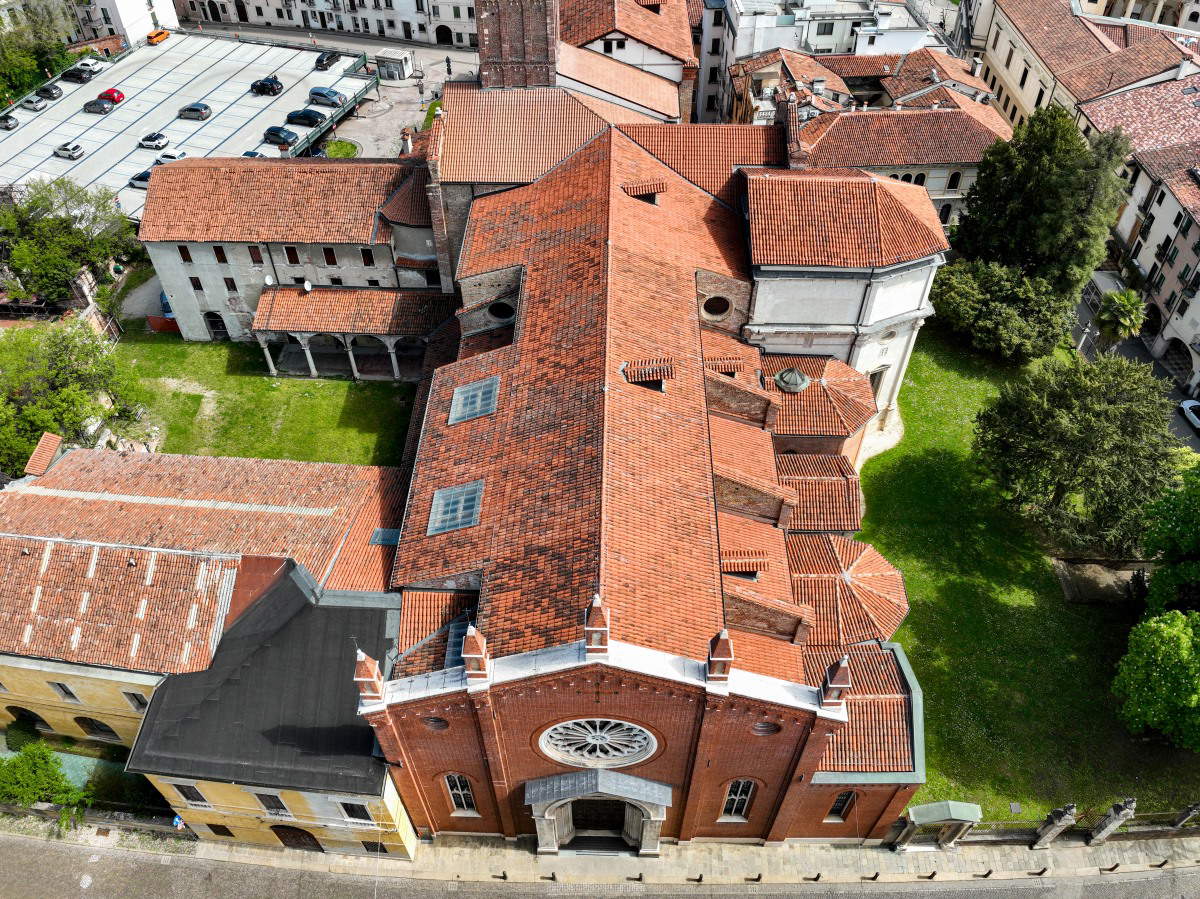
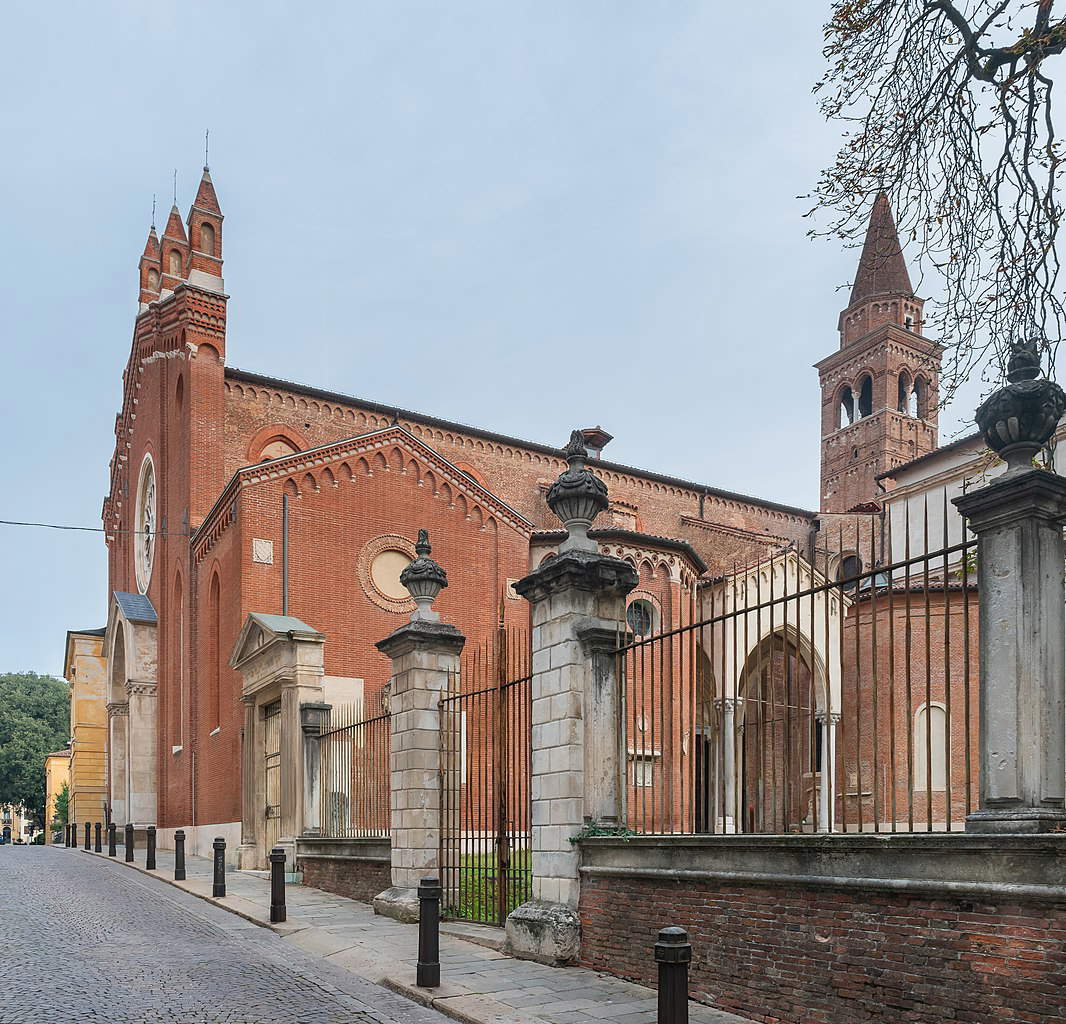
Let us then look at the large altarpiece: at the top, amidst vaporous clouds and heads of cherubs, God the Father stands out, which, however, at a close look does not represent the ideal calling card of a master such as Giovanni Bellini was. This is no coincidence, since the upper portion of the altarpiece was already deeply compromised by the mid-eighteenth century and required restoration. The remaking of that portion was entrusted to Giuseppe Gallo Roberti, a restorer already highly regarded for the restoration of Giorgione’s altarpiece in Castelfranco; the work, however, did not meet expectations and rightly provoked negative reactions. Nonetheless, that figure of questionable quality is still functional today to help perceive the strict vertical direction along which the whole scene unfolds, and which begins outside the painting: from the statue of the Risen Christ, the culmination of the altar, to the high relief with the Madonna suckling the child, then precisely the God the Father, the dove of the Holy Spirit, the hand with the basin of the Baptist, and finally the hieratic and sculptural figure of Christ, the true “axis of the world,” whose magnetic gaze captures that of the viewer.
Also attracting attention is the spot of color on the left, where three female figures witness the Baptism. These are the personifications of the theological virtues: Faith, in yellow robes and with hands joined in prayer; Charity, in the red tunic of Christ; and Hope in the blue mantle of the Savior. Acting as a counterpoint is John the Baptist, painted in earthy tones and placed higher than Christ, who is instead partially immersed in the very clear waters of the Jordan. One cannot fail to notice a seemingly bizarre presence: on a branch cut off in the lower right-hand corner appears a red parrot with green wings: critics have often wondered about this presence, and Cavalcaselle even went so far as to consider it extraneous to the original composition, despite the fact that an iconological reading of it reveals its perfect coherence with the Baptism scene. Fernando Rigon illustrates this well in his monograph Bellini a Vicenza. The Baptism of Christ in Santa Corona (edited by M. E. Avagnina, G. C. F. Villa, Comune di Vicenza, Musei Civici, Biblos, 2007). The colorful bird was in fact known to be able to imitate the human voice and was attributed with the ability to pronounce the word “ave,” a greeting dedicated to the Mother of Jesus. Moreover, in medieval bestiaries the parrot was described as a very clean animal: thus the analogy with Christ born without sin and the link with the rite of purification is evident.
We left for last the analysis of a crucial factor in Giovanni Bellini’s painting: the landscape. “The mantle of nature remains for him an ever-changing whole of almost miraculous beauty, the complete investigation of which will take more than a lifetime, and is therefore endlessly renewable,” wrote Mario Lucco (in Giovanni Bellini, exhibition catalog edited by M. Lucco, G.C.F. Villa, Rome, Scuderie del Quirinale, 2008-2009, Silvana Editoriale, Cinisello Balsamo, 2008, p. 24). From the mid-1570s, the artist focused mainly on light and landscape problems, achieving lofty results: his is “a palette of new tonality, articulated on the diffuse luminescence of brilliant chromatics to give life to a lyrical art, where the intimate essence of a panic Christian sentiment is rendered by a landscape that is no longer a background but an essential part of the painting, a synthesis of history and human feelings,” comments Giovanni Carlo Federico Villa in the already cited catalog. And that in the Vicenza altarpiece the landscape is the protagonist is evident at first glance, when one also notices the band of orange hues in the sky, functional to semantically separate the divine realm, of God the Father, from the earthly realm of his incarnate son and the natural world. Explicit expressions of Bellini’s naturalism are the recognizable plant species in their botanical precision and the sloping atmospheres that fade into the celestial mountains (speaking of the Vicentine landscape, the unforgettable Luigi Meneghello, in his 1974 Pomo pero, wrote: “The lower plane of the world has a rim of celestial mountains and is filled with countries”). It is worth quoting another ancient source, the seventeenth-century Mauro Boschin, who captured very well the Venetian painter’s approach to nature: “Zambelin se puol dir la primavera / Del Mondo tutto, in ato de Pitura: / Perché da lù deriva ogni verdura, / E senza lù l’arte un inverno giera.” Bellini is spring; art before Bellini is winter.
The Baptism of Christ in Vicenza is considered a pinnacle of the maturity of its creator, who must have been in his late seventies at the time and yet compared himself with the younger but already very successful Cima da Conegliano: the dialogue is evident in the similar subject matter painted about ten years earlier by the latter for the church of San Giovanni in Bragora in Verona, but Bellini responds to his rival with a “true visual reform,” a “new accord between humanity divine and nature through figures cast in intense dialogue with the reality of an atmospheric landscape, suggestive rather than descriptive, charged with a well-calibrated pathos” (Villa, scheda Battesimo di Cristo, in Giovanni Bellini, cit., p. 284). An arrangement to which Giorgione and Titian, who in the early sixteenth century were appearing on the art scene of the Serenissima, undoubtedly looked to. Moreover, the iconographic fortune of Bellini’s inventions in the Vicenza altarpiece is evidenced by quotations in later works by Vittore Belliniano, Benedetto Diana, Francesco di Girolamo da Santacroce, and in a faithful engraving by Girolamo Mocetto.
Returning ideally to the interior of the church of Santa Corona, in 1523 the altar commissioned by Garzadori received the remains of his patron: Battista wished to be buried in pilgrim’s robes, wearing the red Jerusalem cross and holding the palm symbolic of the pilgrimage to the Holy Land. Guarding the body, and a reminder of the saving power of the sacrament of baptism, still stands Giovanni Bellini’s altarpiece.

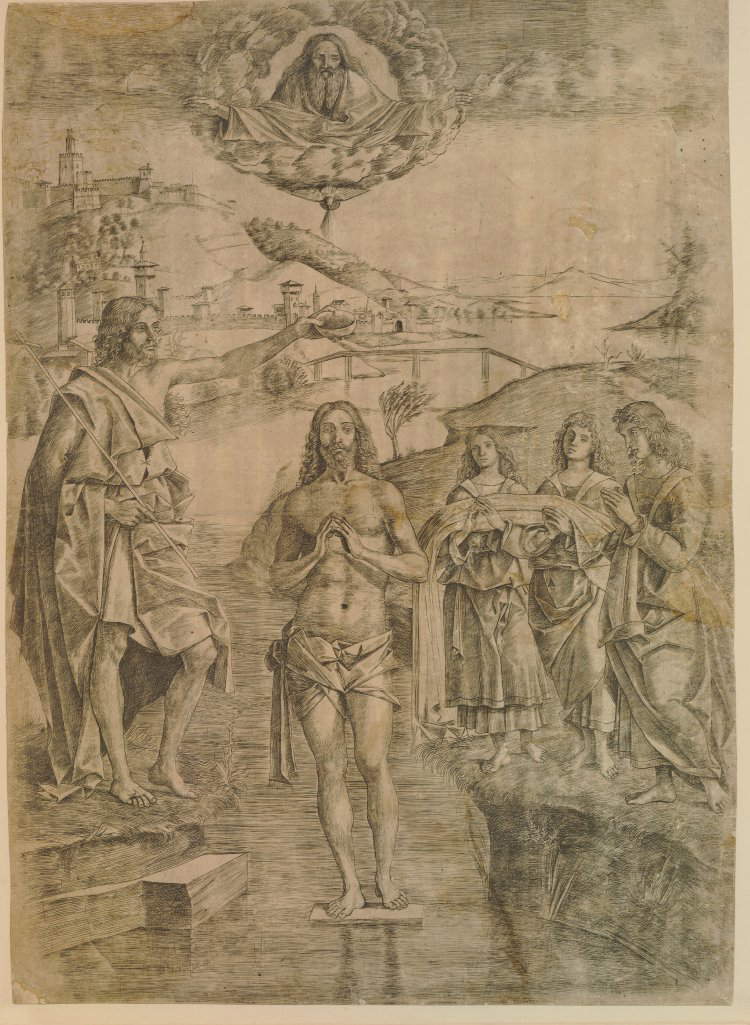
Bellini’s Baptism had a rather complex conservation affair that often saw opposing sides between those who called for restoration work and those who argued that it should not be touched. Summing up the main passages, reported in full in Maria Elisa Avagnina’s essay published in Bellini in Vicenza, by the mid-18th century the upper portion of the painting was already severely damaged, but reverential respect for the work of the Venetian master pushed away the hypotheses of restoration. In 1819 the Municipality of Vicenza expressed grave concerns about the deterioration of the work, but even then nothing was done, and it was not until 1839 that the problem was taken up again, entrusting the restoration to the aforementioned Gallo Lorenzi, a professor at the Royal Academy of Fine Arts in Venice. The latter intervened heavily on both the pictorial surface and the wooden support, and the result was commented on, for example, by Cavalcaselle, then considered an authority: “In Vicenza the famous painting with the Baptism [...] was reduced to a corpse.” A very few years later, in 1846, the painting continued to show lifts in the pictorial and preparatory layers such as to require “welding” interventions, which were repeated in 1915 and 1919, before and after the transfer to Florence to avert risks resulting from World War I. This was followed by restoration by Mauro Pelliccioli of Milan in 1935 and by Ottorino Nonfarmale in 1978. Bellini’s Baptism had to undergo a new “cure” between September 2006 and February 2007: the varnish applied in old restorations had yellowed and was removed, as were the altered remakes that lacked figurative value; all portions of the original color were recovered, while respecting the remakes where the pictorial film laid by Bellini had disappeared. Finally, a very recent intervention completed in May 2022 cleaned up the Garzadori altar, which appeared obscured by deposits of particulate matter, while on the altarpiece further conservation actions were arranged to restore detachments and gaps, as well as the work’s structural support properties.
Warning: the translation into English of the original Italian article was created using automatic tools. We undertake to review all articles, but we do not guarantee the total absence of inaccuracies in the translation due to the program. You can find the original by clicking on the ITA button. If you find any mistake,please contact us.